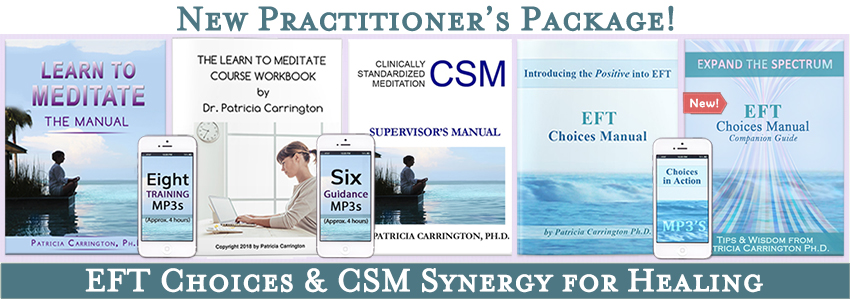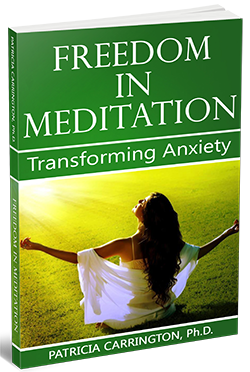In this audio, Dr. Patricia Carrington shares how and why she developed Clinically Standardized Meditation (CSM), which she firs taught this method of meditation to Princeton University students. You will learn about the elimination of the secret mantra, how the basic list of mantras was created, and other adjustments that were made to create CSM.
Listen right now, or download for later. (To download, right click or control click the link)
Play Audio (Duration: 5 minutes 34 seconds)
Why CSM Was Developed
This audio clip is excerpted from Dr. Patricia Carrington’s Learn to Meditate Course
Now, after finding that we (my husband and I) really were getting a great many benefits from meditation and that we were comfortable practicing it, we were ready to start looking into the possibility of recommending it to people. We worked both privately and in clinics and with other people in the general community who simply wanted to find a way of reducing stress. And, who wanted to increase their efficiency in their energy and their enjoyment of life.
When we began to look seriously into this matter, we found that meditation was beginning to be used with a number of different medical conditions. And, that it was also showing a great deal of usefulness for the simply average person who suffers from our fast-paced hectic life, which really means virtually all of us.
In the beginning, we referred people who wanted to learn meditation to various community organizations that taught modern forms of meditation. And, while we got promising results from doing this, we soon found it was necessary to teach the meditation and to regulate it ourselves. We had decided that in Westernized, scientific meditation it’s not appropriate to assign anyone a mantra that is a word to use while they meditate, by any secret process, or by any process with a person whose learning it has no control over the word that selected.
Although some people certainly learned, successfully, to meditate using words assigned by a sacred practice, there are a good many people who don’t care for this at all. We had also noticed that exactly the same directions for meditating can’t be applied to everyone. Some people can start out meditating for 15 to 20 minutes at one time, and they do beautifully. And, others can’t tolerate this amount of time at first, and some may never be able to tolerate it. But if these people start with 10 minutes, or less, of meditation they can usually do very well. And, we also found that there are a number of other adjustments, which can be made when you’re learning meditation that can make all the difference between successful meditation and an unsuccessful and disappointing experience.
The next step, then, was to devise an appropriate kind of meditation, which would take into account these factors. I developed the new form of meditation you’ll be learning by selecting a classical type of Mantra meditation, which has been used for centuries in India, and modifying it so that it became a relaxation technique, which is suitable for people in the Western world.
The first group of people who used this form of meditation were my students at Princeton University, who were attending a meditation seminar that I was giving. These students were very enthusiastic about the meditation and its effects on them. And, on a series of personality tests that I gave to them, before they learned the meditation and again after they practiced it for 10 weeks, they showed clear-cut evidence that their anxiety level had reduced significantly over that 10 weeks period.
This basic technique of meditation was then revised, and tried out with people from all walks of life and all different ages, and given the name Clinically Standardized Meditation to indicate that, as well as being used for the purpose of promoting relaxation and personal growth for the general public, it can also be used for clinical and research purposes.
People who are learning Clinically Standardized Meditation are allowed to choose their own mantra from a list of 16 mantras derived from ancient sources. Originally, I gathered these resonant sounds by going to the Sanskrit section of the Princeton library and pouring over volumes, which contain literally thousands of traditional mantras from India. So, I chose a hundred of the more melodious mantras and made up a basic list, which I then handed to a number of subjects who were asked to check those sounds, out of the hundred, which they found most pleasant and soothing. I then took the 16 sounds, which had most frequently been selected by this group, and these became the basic list of mantras, which you will be using when you select your mantra for meditation.
Each person learning Clinically Standardized Meditation is asked to select a mantra which they prefer. In other words, they have control over what thought they will be repeating in their minds, while they meditate. Most people find at least one of the sounds on the list appealing to them and comfortable, but any sound of one’s own choosing can be used, provided the person follows a few simple rules for making up their own mantra.
You’ll learn how to during the course when you come to select your sound. Clinically Standardized Meditation has been used successfully with a large number of people who want to learn an effective relaxation technique.
 This easy-to-follow instruction kit contains downloads of the 8 audios, plus the Learn to Meditate Manual (PDF) and the Interactive PDF Workbook. Using this method you can master meditation within a week and feel its powerful effects at once. See complete details…
This easy-to-follow instruction kit contains downloads of the 8 audios, plus the Learn to Meditate Manual (PDF) and the Interactive PDF Workbook. Using this method you can master meditation within a week and feel its powerful effects at once. See complete details…






